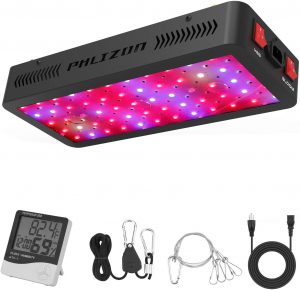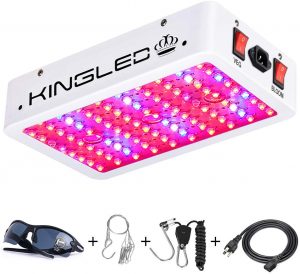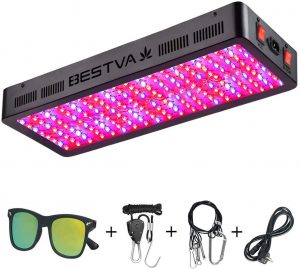4 Types of Indoor Plant Grow Lights
When growing indoors, one of the most important purchases is your lighting. The lighting will be your replacement for the sun. We all know without the sun nothing will grow. And if you are growing inside without a light it will be much harder to grow anything.
Investing in a grow light will give you one of the best returns on your investment with the success of your plant growth.
With grow lights you can do more than just grow indoors for the full life of the plant. You can also prepare for the upcoming season. During the end of winter you can get your seeds started indoors and get them ready for when the ground warms up.
You can use the lights to help while propagating and getting cuttings ready to plant. If you have some plants that need some extra daylight you can bring them in and put them under your grow lights.
There are 4 types of bulbs that produce light
- Incandescent (Least efficient and don’t produce good enough light for plant growth)
- CFL
- High Pressure Sodium
- LED
Light Spectrum
When selecting a light you need to know a little about the light spectrum. All light falls somewhere within the spectrum whether visible to the human eye or not. The spectrum is measured in Nanometers. For growing plants indoors we want the wavelengths to fall between 400-700 Nanometers. This range is known as PAR Spectrum or Photosynthetically Active Radiation.
This range is the range of wavelengths that plants can actually use for photosynthesis. Plants will use both the blue light with the range of 425-450 Nanometers and the Red Light between 600-700 nanometers.
Plants produce their energy through the process called photosynthesis. They do this by absorbing carbon dioxide, water and minerals and converting it to oxygen.
4 Types of Lights
- Incandescent
- CFL Lights
- High Pressure Sodium
- LED Lights
Since Incandescent does not produce good enough light for plants to grow we will not be discussing it in this article. So we will be jumping straight to CFL Lights.
CFL Lights
CFL Bulbs were first invented in the 1890s but didn’t really become popular until the 1970s when they became more economic. They consume 1/3 to 1/5 of traditional incandescent light bulbs. And they last 7 to 10 times as long.
They admit blue and red spectrum wavelengths that combine to make the white light you see. The further you have the CFL bulb away from the plant the less effective they are . They are available in most stores and are the cheapest forms of light of all three.
High pressure sodium
High pressure sodium lights were invented in the mid 1950’s For growing vegetables they are more flexible because they produce more usable light wavelengths You can have your plants further away from the light than you can with CFL bulbs.
They produce a lot of heat and can require you to have ventilation. The price is more expensive than CFL lights and the energy efficiency is not as good and they don’t last as long
LED Lights
The light spectrum appropriate for growth was only just invented in the 21st Century. However they are fast becoming the light of choice for growers. They are by far the most efficient of the 3 lights.
LED has a lifespan of 6 to 7 times greater than CFL and has practically zero heat produced. Plants do not need to be close to the lights to provide benefits. Unlike the other 2 lights LED lights are able to emit exact wavelengths of light that target photosynthesis that allow them to specialize in plant growth.
Oftentimes you will see a purple light which is a combo of both the red and blue spectrum that is needed by the plants. These lights are perfect for plants but you will need to be careful when looking into the lights. They are not good for our eyes.
You will find LEDs in your regular stores and technically it is possible to grow plants with these lights however these lights are not built for plant growth. Because of this it is best to purchase specialized LED lights if you plan on using them for your plants.
Unfortunately these more specialized lights are a bit more expensive than the standard LED lights but they are a great investment if you are serious about growing indoors.
How to choose the right Lights
When looking for Grow lights you want to get the correct wavelengths measured in Kelvin and higher watt bulbs that emit more light for your plants. It’s important to have the Blue and Red spectrum that the plants use.
Kelvin is a unit of measurement describing the spectrum of light emitted. Kelvin ratings of 6500 and 2100 hit the blue and red spectrum respectively. This is perfect when selecting the right light with the highest wattage possible.
Lumens are not the best indicator when selecting lights. Lumens are the measurement of the visible lights hitting a square area. Visible light to humans is only a small part of the spectrum and does not hit the blue and red spectrum the plants need.
Based on the above information I recommend and suggest LED Lights for indoor growing.
Top LED Bulbs for Growing Indoors
 Phlizon Newest 600W LED Plant Grow Light
Phlizon Newest 600W LED Plant Grow Light- DOUBLE SWITCH- Veg and Bloom buttons have different functions. The Veg switch: Is blue LED and white LED. Use the Veg switch for for seedlings or young vegetative growth.. Bloom switch: It’s red LED and white LED. Once you have flowering/blooming, you can use both Veg and Bloom switches together.
- FULL SPECTRUM- We did lots of experiments to ensure that this full spectrum promotes plant growth. It includes universal blue red IR UV and white leds which can provide everything plant desired in the natural sunlight.
- BEST SERVICE- Phlizon is a professional LED light manufacturer with strong R&D team and many light tester. 2 years warranty plus 30 days money back guarantee.
 King Plus 1000w LED Grow Light
King Plus 1000w LED Grow Light- Veg/Bloom Switch – the double switch, was designed to provide proper light for plants in different growth stages to greatly increase your harvest. Veg switch is the blue LED and white LED only used for seed or seedling growth; Bloom switch is the red LED and white LED. For flowering, both Veg and Bloom switches can be used.
- Full spectrum: KingLED LED grow light provides full spectrum lighting from 380 nm to 780 nm (including UV + IR) of natural light for plants needed of all growing stages from vegetables to flowers.
- Energy-saving technology: Different from the traditional HPS ,Our LED plant grow lamp adopts a high-tech LED chip(double-chip 10W LED),
- Advanced cooling system: Multiple high-speed mute fans and upgraded aluminum radiators enable the light bulb to work at 50°F to 60°F that is lower than other lamps.
- Professional Service:3 years Professional Service and free return for 90 days.
 BESTVA DC Series 2000W LED Grow Light
BESTVA DC Series 2000W LED Grow Light - Dual-chip(10W) LEDs which are much brighter and more efficient than traditional 3W and 5W LEDs. It is the HIGHEST PAR/LUMEN OUTPUT PER WATT
- VEG & BLOOM Switches Nine different bands of LEDs make up our true full spectrum light, which helps plants, vegetables and flower indoor growing at all stages, just like in the natural sunshine
- Powerful Cooling System We use a 3mm thickness aluminum plate radiator for better heat dissipation
- Core Coverage Area Compare to 1400 watt HPS while consuming only 390 watts!
- 3 years warrantyPlus 90 days satisfaction or return guarantee.
 VIPARSPECTRA UL Certified 600W LED Grow Light
VIPARSPECTRA UL Certified 600W LED Grow Light- UL Certified Lighting SAFETY is just as important as EFFICIENCY. The V600 as a whole is UL Certified. It meets UL rigorous testing and safety standards to ensure safe operation.
- Optimal Spectrum & VEG & BLOOM Switches The secret to VIPARSPECTRA’s success is optimal full spectrum lighting which provides plants in all stages from veg to flower with everything they need in the natural sunlight.
- Daisy Chain FunctionDaisy Chain feature assists growers to connect multiple lights together with fewer outlets.
- Coverage area & Hanging height: The 600W LED grow light is perfect for a 3’x3’ vegetative coverage at 32”and 2.5’x2.5’ flowering coverage at 22”.
- Worry-free 3 Years US warranty: We are a professional manufacturer who specializes in LED grow lights for many years.
